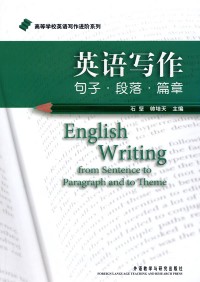
微信扫一扫,移动浏览光盘
简介
《高等学校英语写作进阶系列?英语写作?句子段落篇章》介绍:
从事高校英语写作教学及研究多年,一直向往一整套供师生从低年级到高年级使用的写作教材。这套教材应包括基础英语写作、英语应用文写作和高级阶段的英语论文写作。在基础阶段,英语写作应从句子到段落,再到篇章,帮助学生打下坚实的英文写作基础;应用文写作则为增强学生应用英语进行交际的能力添砖加瓦;在高级阶段,论文写作应从普通论文讲起,再到学术论文,初步培养学生从事学术研究,撰写学术文章的能力。这套教材可分阶段自成体系,但从知识和技能的讲解及训练规划上讲,应循序渐进,具有连贯性。这套教材应有很好的可操作性,理论的讲解和技巧的介绍应深入浅出、环环相扣,且能及时和准确地得到操练,转化为学生的“知识”。这套教材既然是英文教材,必须让学生在使用过程中自始至终沉浸在英美语言文化的浓厚氛围之中,逐步脱离汉语母语的影响,养成新的写作习惯,写出地道的英语文章。让中国学生把英语文章写得真正像英美人士所写,并非易事,但正因为此,一套好的英语写作教材,更应把东西方思维模式、行为方式、生活习惯等对各自语言和语言的应用的影响说得使人信服;更应跟进国外读与写联姻的新潮,在避免目前国内读写教材读是读、写是写的做法的同时,安排充足的范文、例句,服务于写作知识与技巧的介绍,把读和写真正有机地联系在一起,提高学生对英语语言的认知能力和对第一语言者思维和行文方式的认识。这样的写作教材,让人向往,也给人以创作的冲动。 “高等学校英语写作进阶系列”正是这种创作冲动的产物。
‘ 作为本系列教材中的分册, 《英文写作——句子?段落?篇章》的主要读者对象为大学本科低年级学生,对其他英文学习者和工作者而言,不乏为一部指导陛的参考用书。
目录
Part One A General Introduction to English Writins
Ⅰ Writing in Our World
Ⅱ Types of Writing
1 Narration
2 Description
3 Exposition
Ⅲ Writing Well in English
1 Following the English Thought Pattern
2 Seeking Clarity, Brevity, and Variety
3 Considering Our Purpose and Our Audience's Usage Levels
Part Two From Sentence to Paragraph
Ⅰ Sentence Structure
1 Elements of a Sentence
2 Kinds of Sentences
3 Clause Connectors
4 Coordination and Subordination
5 Parallelism
Ⅱ Paragraph Structure
1 The Basic Paragraph
2 Four Elements of the Paragraph
3 Mechanics in Writing a Paragraph
Ⅲ Basic Paragraph-Building Skills
1 Taking Three Pre-Writing Steps
2 Making Our Topic Sentence a Helpful Guide
3 Loading Our Topic Sentence with a Strong Controlling Idea
4 Writing a Helpful Outline in Advance
5 Gaining Unity
6 Gaining Coherence from Logical Order
7 Gaining Coherence from Transitions
8 Gaining Better Unity and Coherence from Punctuation
Ⅳ Sentence Problems
1 Sentence Fragments
1) Fragments Without Verbs
2) Fragments Without Subjects
3) Fragments Without Subjects and / or Verbs
4) Fragments of Dependent Clauses
2 Choppy Sentences
3 Run-Together Sentences
4 Stringy Sentences
5 Confusing Shifts
1) Confusing Shifts in Person
2) Confusing Shifts in TenSe
3) Confusing Shifts in Subject and Voice
4) Confusing Shifts in Mood or Speech
5) Confusing Shifts in Number
6) Mixed Sentence Construction
6 Incomplete Constructions
1) Careless Omissions
2) Incomplete Comparisons
7 Ambiguous Pronoun Reference
1) A Pronoun with Two or More Possible Antecedents
2) A Pronoun Without a Clearly Expressed Antecedent
3) The Pronouns lt, They, and You with Indefinite Antecedents
4) The Pronouns This, That, and Which Referring to General Ideas
5) A Pronoun Too Far Away from Its Antecedent
8 Dangling Modifiers
1) Danglin Participial Modifiers
2) Dangling Gerunds in Prepositional Phrases
3) Dangling Infinitive Modifiers
4) Dangling Abbreviated Clauses
9 Misplaced Modifiers
1) Misplaced Prepositional Phrases
2) Misplaced Adjective Clauses
3) Misplaced Adverbial Modifiers
10 Wordiness ~
1) Needless Repetition
2) Needless Expansion
3) Awkward Cliches
4) Overwritten Style
Part Three From Paragraph to Theme
Ⅰ Introduction
Ⅱ Three Kinds of Paragraph
1 The Introductory Paragraph
2 The Body Paragraph
3 The Concluding Paragraph
Ⅲ Basic Theme-Building Skills
1 Getting the Theme Well-Unified with an Effective Thesis Statement
2 Getting the Theme Coherent with Transitions Between Paragraphs
3 Developing the Theme Under the Guidance of a Well-Organized Outline
1) Theme of Process in Time Order
2) Theme of Description in Order of Importance
3) Theme of Classification in Order of Importance
4) Theme of Comparison and Contrast in Order of Importance
5) Theme of Cause and Effect in Order of Importance
6) Theme of Exemplification in Time Order, or Order of Importance
Ⅳ Sample Themes Observed
Part Four Summary and Book Report
Ⅰ Summary Writing
Ⅱ Book Report Writing
Correction Symbols
Partial Answers to Exercises
Bibliography
Ⅰ Writing in Our World
Ⅱ Types of Writing
1 Narration
2 Description
3 Exposition
Ⅲ Writing Well in English
1 Following the English Thought Pattern
2 Seeking Clarity, Brevity, and Variety
3 Considering Our Purpose and Our Audience's Usage Levels
Part Two From Sentence to Paragraph
Ⅰ Sentence Structure
1 Elements of a Sentence
2 Kinds of Sentences
3 Clause Connectors
4 Coordination and Subordination
5 Parallelism
Ⅱ Paragraph Structure
1 The Basic Paragraph
2 Four Elements of the Paragraph
3 Mechanics in Writing a Paragraph
Ⅲ Basic Paragraph-Building Skills
1 Taking Three Pre-Writing Steps
2 Making Our Topic Sentence a Helpful Guide
3 Loading Our Topic Sentence with a Strong Controlling Idea
4 Writing a Helpful Outline in Advance
5 Gaining Unity
6 Gaining Coherence from Logical Order
7 Gaining Coherence from Transitions
8 Gaining Better Unity and Coherence from Punctuation
Ⅳ Sentence Problems
1 Sentence Fragments
1) Fragments Without Verbs
2) Fragments Without Subjects
3) Fragments Without Subjects and / or Verbs
4) Fragments of Dependent Clauses
2 Choppy Sentences
3 Run-Together Sentences
4 Stringy Sentences
5 Confusing Shifts
1) Confusing Shifts in Person
2) Confusing Shifts in TenSe
3) Confusing Shifts in Subject and Voice
4) Confusing Shifts in Mood or Speech
5) Confusing Shifts in Number
6) Mixed Sentence Construction
6 Incomplete Constructions
1) Careless Omissions
2) Incomplete Comparisons
7 Ambiguous Pronoun Reference
1) A Pronoun with Two or More Possible Antecedents
2) A Pronoun Without a Clearly Expressed Antecedent
3) The Pronouns lt, They, and You with Indefinite Antecedents
4) The Pronouns This, That, and Which Referring to General Ideas
5) A Pronoun Too Far Away from Its Antecedent
8 Dangling Modifiers
1) Danglin Participial Modifiers
2) Dangling Gerunds in Prepositional Phrases
3) Dangling Infinitive Modifiers
4) Dangling Abbreviated Clauses
9 Misplaced Modifiers
1) Misplaced Prepositional Phrases
2) Misplaced Adjective Clauses
3) Misplaced Adverbial Modifiers
10 Wordiness ~
1) Needless Repetition
2) Needless Expansion
3) Awkward Cliches
4) Overwritten Style
Part Three From Paragraph to Theme
Ⅰ Introduction
Ⅱ Three Kinds of Paragraph
1 The Introductory Paragraph
2 The Body Paragraph
3 The Concluding Paragraph
Ⅲ Basic Theme-Building Skills
1 Getting the Theme Well-Unified with an Effective Thesis Statement
2 Getting the Theme Coherent with Transitions Between Paragraphs
3 Developing the Theme Under the Guidance of a Well-Organized Outline
1) Theme of Process in Time Order
2) Theme of Description in Order of Importance
3) Theme of Classification in Order of Importance
4) Theme of Comparison and Contrast in Order of Importance
5) Theme of Cause and Effect in Order of Importance
6) Theme of Exemplification in Time Order, or Order of Importance
Ⅳ Sample Themes Observed
Part Four Summary and Book Report
Ⅰ Summary Writing
Ⅱ Book Report Writing
Correction Symbols
Partial Answers to Exercises
Bibliography
English writing:from sentence to paragraph and to theme
- 名称
- 类型
- 大小
光盘服务联系方式: 020-38250260 客服QQ:4006604884
云图客服:
用户发送的提问,这种方式就需要有位在线客服来回答用户的问题,这种 就属于对话式的,问题是这种提问是否需要用户登录才能提问
Video Player
×
Audio Player
×
pdf Player
×


